A Comprehensive Guide: How to Successfully Implement AI Analytics in Your Business
The potential of AI analytics to optimize your business operations and drive innovation for seamless customer experience with data-driven solutions
Read moreAIOps and analytics foster a culture of continuous improvement by providing organizations with actionable intelligence to optimize workflows, enhance service quality, and align IT operations with business goals.

Next-generation application management fueled by AIOps is revolutionizing how organizations monitor performance, modernize applications, and manage the entire application lifecycle.
The critical significance of AIOps for transforming IT operations lies in its ability to drive proactive issue resolution, enhance operational efficiency, and enable data-driven decision-making. By embracing AIOps technologies, organizations can navigate the complexities of modern IT landscapes, unlock operational synergies, and position themselves for sustained success in a rapidly evolving digital ecosystem.
Automation in IT operations enable agility, resilience, and operational excellence, paving the way for organizations to adapt swiftly to changing environments, deliver superior services, and achieve sustainable success in today's dynamic digital landscape.
Advanced analytics encompasses leveraging sophisticated machine learning (ML) algorithms and visualization techniques to extract insights from data, uncovering latent patterns and trends. Organizations utilize this approach to enhance business operations, mitigate risks, and tailor customer experiences.
According to Gartner, by 2026, 50% of organizations will need to assess Analytic Business Infrastructure (ABI) and Data Science and Machine Learning (DSML) platforms as integrated solutions due to market convergence.
Here are industry-specific applications of advanced analytics:
Cloud analytics harnesses scalable cloud computing and advanced analytic software to discern patterns in data and unearth fresh insights, empowering organizations with comprehensive data intelligence.
As per Gartner, by 2025, cloud Database Management System (DBMS) revenue is projected to exceed two-thirds of the total DBMS market revenue.
Organizations leverage cloud analytics to:
Real-time analytics involves immediate delivery of insights to businesses once data is collected, meeting the demand for accelerated analytical speeds amidst escalating data volumes.
By 2025, vendors employing continuous intelligence to unify actions across organizational silos are likely to increase revenue 3x faster than their counterparts.
Here’s how organizations harness the benefits of real-time analytics:
“According to Gartner study, companies that leverage predictive analytics and AIOps can achieve up to a 25% reduction in unplanned downtime.”
Predictive analytics, coupled with Artificial Intelligence for IT Operations (AIOps), revolutionizes how enterprises manage and optimize their IT infrastructure. By leveraging advanced algorithms and machine learning techniques, predictive analytics anticipates future events based on historical and real-time data. AIOps complements this by automating IT operations, detecting anomalies, and facilitating proactive problem resolution.
Ready to unlock the transformative potential of predictive analytics and AIOps for your enterprise? Check out here on how you can revolutionize your operations and drive growth.
AI analytics refers to the application of AI technologies to analyze data, extracting insights, and making data-driven decisions. It empowers organizations to automate repetitive tasks, predict outcomes, and gain a competitive edge in today’s data-driven landscape. From predictive insights to process optimization, the potential benefits are immense.
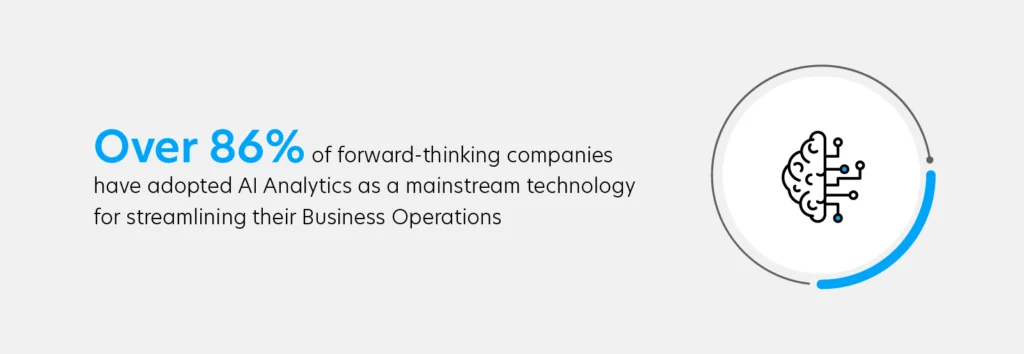
However, the path to successful AI analytics implementation is riddled with challenges that demand careful navigation. Here’s a look at some key challenges and how to navigate them:
Challenge 1: AI’s efficacy hinges on the quality of its training data.
Solution: Establish robust data governance, quality checks, and a centralized data platform.
Challenge 2: AI system development demands niche skills, posing recruitment and retention hurdles.
Solution: Upskill workforce skills via training, partnering with external AI experts for projects.
Challenge 3: Employee pushback may arise due to fears of AI displacing human jobs.
Solution: Cultivate transparent culture, clarifying AI’s role in job augmentation, not replacement.
Challenge 4: AI algorithms may amplify biases present in datasets, resulting in unjust results.
Solution: Integrate fairness checks, involve diverse teams in AI development and monitoring.
Challenge 5: Opacity in AI models complicate comprehension of decision-making processes.
Solution: Invest in Explainable AI (XAI) techniques for insights into AI output reasoning.
By proactively addressing these challenges, enterprises can unlock the true potential of AI analytics and gain a significant competitive advantage.
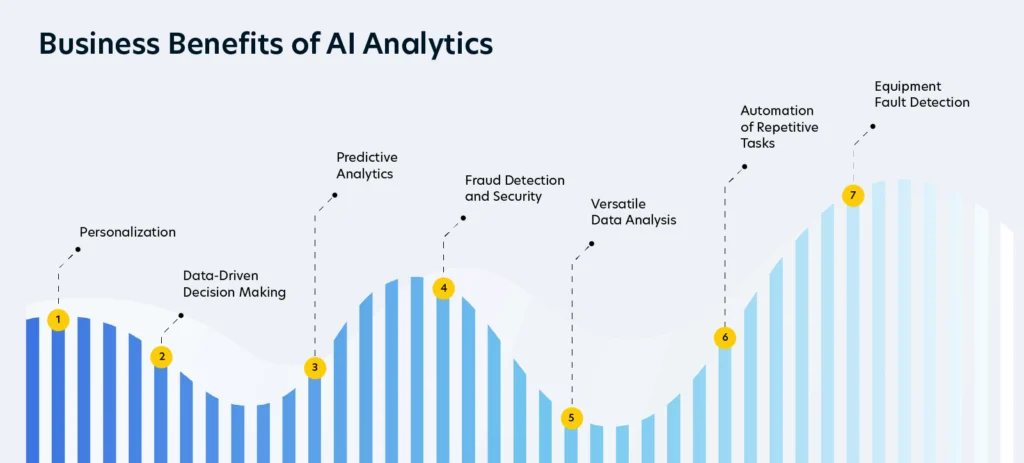
Are you still lagging in reaping benefits of AI Analytics. Connect with us today and explore how we can help you navigate the path to successful AI implementation.
In a world where every byte counts, Big Data Analytics is a guiding beacon for businesses, helping them make informed decisions based on comprehensive insights from vast amounts of data. By analyzing data patterns, trends, and correlations, companies can identify areas of inefficiency and streamline operations to cut down on unnecessary costs.
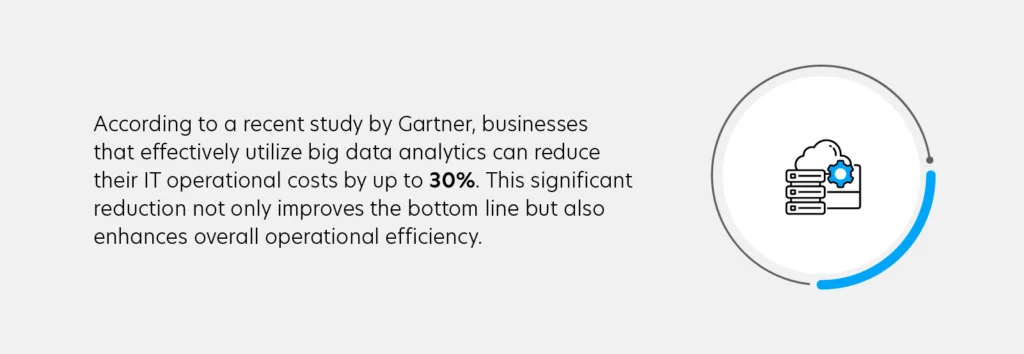
But how do AIOps fit into this equation? AIOps leverages advanced algorithms and machine learning techniques to automate IT operations and enhance performance monitoring, making it a perfect complement to Big Data Analytics in businesses. By integrating AIOps with Big Data Analytics, businesses can proactively identify and resolve IT issues, optimize resource utilization, and reduce IT costs.
Quick Insight: “Companies leveraging big data analytics are 23 times more likely to outperform their competitors in terms of new customer acquisition?”
With the right analytics tools in place, businesses can:
In essence, the synergy between big data analytics and AIOps empowers businesses to not only reduce IT costs but also enhance agility and innovation.
Connect with Our Experts and take control of your IT costs Now!
Augmented analytics stands at the forefront of a data revolution, offering businesses a powerful tool to extract meaningful insights from vast datasets with unprecedented speed and accuracy. By combining artificial intelligence, machine learning, and natural language processing, augmented analytics enables users to uncover valuable patterns, trends, and anomalies in their data effortlessly.
Augmented analytics is closely linked to AIOps, a strategic approach that combines artificial intelligence and machine learning with IT operations to improve the efficiency and reliability of IT systems. By integrating augmented analytics into AIOps practices, businesses can automate the detection and resolution of IT issues, predict potential failures, and optimize system performance in real-time. This proactive approach not only reduces downtime and operational costs but also enhances the overall resilience and agility of IT infrastructure.
Augmented analytics offers a plethora of benefits for businesses seeking to enhance their IT efficiency and drive operational excellence. Here are some key advantages of leveraging augmented analytics in the realm of IT operations:
Augmented analytics automates data preparation, cleansing, and integration processes, allowing IT teams to focus on strategic tasks rather than routine data management. This automation accelerates the analysis process and ensures that insights are derived from clean and reliable data.
By incorporating machine learning algorithms and predictive analytics, augmented analytics provides IT teams with advanced data insights and predictions. This enables proactive problem-solving, anomaly detection, and trend forecasting, empowering organizations to address issues before they escalate.
Augmented analytics facilitates real-time monitoring of IT systems by continuously analyzing data streams and generating alerts for potential issues or discrepancies. This proactive approach helps IT teams identify and resolve issues promptly, minimizing downtime and optimizing system performance.
Augmented analytics equips decision-makers with actionable insights derived from complex data sets, enabling informed and data-driven decisions. By understanding trends, patterns, and correlations in IT data, organizations can make strategic choices that drive operational efficiency and improve overall performance.
With augmented analytics, businesses can optimize resource allocation by identifying areas where resources are underutilized or overburdened. This insight allows IT leaders to allocate resources effectively, streamline processes, and improve workflow efficiency.
By leveraging predictive analytics capabilities within augmented analytics tools, businesses can implement predictive maintenance strategies for IT infrastructure. This proactive approach helps prevent system failures, reduce downtime, and extend the lifespan of IT assets.
Forrester Research highlights that companies that invest in financial analytics experience a 20% increase in revenue, a 15% reduction in operational costs, and a 25% improvement in forecasting accuracy. This statistic underscores the growing importance of data-driven decision-making in modern business environments, with financial analytics playing a crucial role in shaping strategic direction and ensuring long-term success. By leveraging advanced analytical tools and techniques, financial analytics empowers organizations to analyze financial data, monitor key metrics, assess risks, and forecast future trends accurately.
Businesses need to leverage financial analytics to gain a deeper understanding of their financial performance, make informed decisions, and drive sustainable growth. Here are several compelling reasons why businesses should prioritize the use of financial analytics:
Financial analytics provide businesses with actionable insights derived from data analysis, enabling decision-makers to base their strategies on facts rather than intuition. By leveraging financial data, organizations can make informed decisions that are aligned with their financial goals and objectives.
Financial analytics allow businesses to monitor key financial metrics, track performance trends, and identify areas of strength and improvement. This enables organizations to proactively address financial challenges, optimize resource allocation, and capitalize on emerging opportunities.
Financial analytics help businesses assess risks, identify potential vulnerabilities, and implement mitigation strategies to safeguard against financial uncertainties. By analyzing historical data and market trends, organizations can anticipate risks and take proactive measures to mitigate their impact.
Financial analytics enable businesses to forecast future financial scenarios, plan budgets, and set realistic financial targets. By utilizing predictive modeling and scenario analysis, organizations can project revenue, expenses, and cash flow, allowing for better financial planning and resource allocation.
Financial analytics can highlight areas of inefficiency, unnecessary expenses, and opportunities for cost savings. By analyzing cost drivers and performance indicators, businesses can streamline operations, reduce wastage, and optimize cost structures to improve profitability.
Financial analytics help businesses ensure compliance with financial regulations, standards, and reporting requirements. By maintaining accurate financial records, conducting thorough analysis, and generating compliant reports, organizations can uphold transparency, accountability, and regulatory adherence.
According to Gartner, organizations that effectively utilize analytics are likely to outperform their peers financially by 20%. By leveraging enterprise analytics, businesses can enhance operational efficiency, identify new revenue opportunities, mitigate risks, improve customer relationships, and innovate products and services based on market demands and trends.
Enterprise analytics encompasses a range of analytical approaches, including descriptive analytics (which focuses on summarizing historical data), diagnostic analytics (which aims to understand why certain events occurred), predictive analytics (which forecasts future trends and outcomes), and prescriptive analytics (which recommends actions based on analysis). By leveraging these analytics methods, businesses can uncover patterns, trends, correlations, and anomalies within their data to make informed decisions that drive business success. It enables businesses to identify areas for improvement, optimize resource allocation, personalize customer experiences, innovate products and services, and stay agile in a rapidly evolving business environment. By harnessing the power of data and analytics, enterprises can unlock new opportunities, drive innovation, and achieve sustainable growth in today’s data-driven economy.
In the realm of IT operations, AIOps leverages advanced analytics, machine learning algorithms, and automation to proactively monitor IT systems, detect anomalies, predict issues, and facilitate rapid incident resolution. By combining enterprise analytics with AIOps capabilities, businesses can gain real-time visibility into IT performance, optimize resource allocation, improve system uptime, and deliver seamless digital experiences to users.
Analytical intelligence refers to the ability of organizations to leverage advanced analytics tools, techniques, and methodologies to extract valuable insights from data, enabling informed decision-making, strategic planning, and operational optimization. This form of intelligence involves the systematic analysis of structured and unstructured data to uncover patterns, trends, correlations, and anomalies that can drive business outcomes and competitive advantage.
Analytical intelligence equips enterprises with the capability to make data-driven decisions based on evidence and insights rather than intuition or guesswork. By analyzing data effectively, organizations can optimize processes, allocate resources efficiently, and capitalize on emerging opportunities.
In today’s competitive landscape, analytical intelligence is a key differentiator for enterprises. By gaining deeper insights into market trends, customer behaviors, and operational efficiencies, businesses can stay ahead of the curve, innovate proactively, and outperform their competitors.
Analytical intelligence enables enterprises to streamline operations, identify bottlenecks, and enhance productivity. By optimizing workflows, resource allocation, and performance metrics, organizations can achieve greater efficiency and cost savings.
By analyzing data for potential risks, vulnerabilities, and market fluctuations, enterprises can proactively mitigate risks and plan for contingencies. Analytical intelligence helps businesses anticipate challenges, respond swiftly to disruptions, and safeguard their interests.
Understanding customer preferences, behaviors, and feedback through analytical intelligence allows enterprises to personalize interactions, tailor marketing strategies, and improve overall customer satisfaction. By delivering targeted and relevant experiences, businesses can foster loyalty and long-term relationships with their customers.
Analytical intelligence fuels innovation by identifying emerging trends, untapped markets, and new product opportunities. By leveraging data insights, enterprises can drive product development, create competitive offerings, and adapt to changing consumer demands effectively.
Data insights refer to meaningful and actionable conclusions drawn from the analysis of data sets, enabling businesses to make informed decisions, identify trends, predict outcomes, and drive strategic initiatives. These insights are derived through various analytical techniques, such as data mining, machine learning, and statistical analysis, to extract valuable information from raw data.
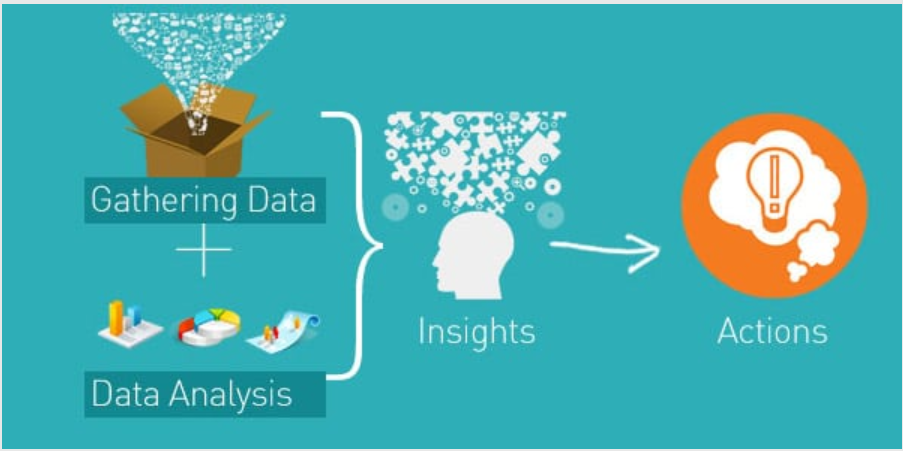
Data insights are crucial for businesses as they provide a competitive edge in today’s data-driven marketplace. By leveraging data insights, organizations can gain a comprehensive understanding of their operations, customer behavior, market trends, and performance metrics. This knowledge empowers businesses to optimize processes, enhance customer experiences, target marketing efforts effectively, and adapt quickly to changing market dynamics.
In the implementation of an AIOps strategy, data insights play a vital role in optimizing IT operations, improving system performance, and enhancing overall efficiency. By harnessing data insights generated through AI and machine learning algorithms, businesses can:
Data insights enable proactive monitoring of IT systems by detecting anomalies, identifying patterns, and predicting potential issues before they occur. This proactive approach helps minimize downtime, prevent disruptions, and ensure seamless operation of IT infrastructure.
Data insights help businesses optimize resource allocation by identifying areas of underutilization or overutilization within IT operations. By analyzing data on resource usage and performance metrics, organizations can allocate resources more effectively, improve scalability, and enhance operational efficiency.
Data insights derived from historical data and real-time monitoring enable predictive maintenance strategies. By analyzing trends and patterns in system performance data, businesses can anticipate equipment failures, schedule maintenance proactively, and reduce the risk of costly downtime.
Data insights facilitate faster incident resolution by providing IT teams with valuable information on past incidents, root causes, and resolution strategies. By leveraging historical data and analytics, organizations can streamline incident management processes, improve response times, and enhance service quality.
By integrating data insights into the implementation of an AIOps strategy, businesses can unlock the full potential of AI-driven IT operations, improve decision-making, optimize performance, and drive operational excellence in a dynamic and evolving digital landscape.
Causal analysis, also known as causal inference, is the process of identifying and understanding the causal relationships between variables or events. In business contexts, causal analysis involves determining the cause-and-effect relationships that drive specific outcomes or behaviors within an organization. By exploring these causal links, businesses can gain valuable insights into the factors influencing their performance, customer behavior, market trends, and overall success.
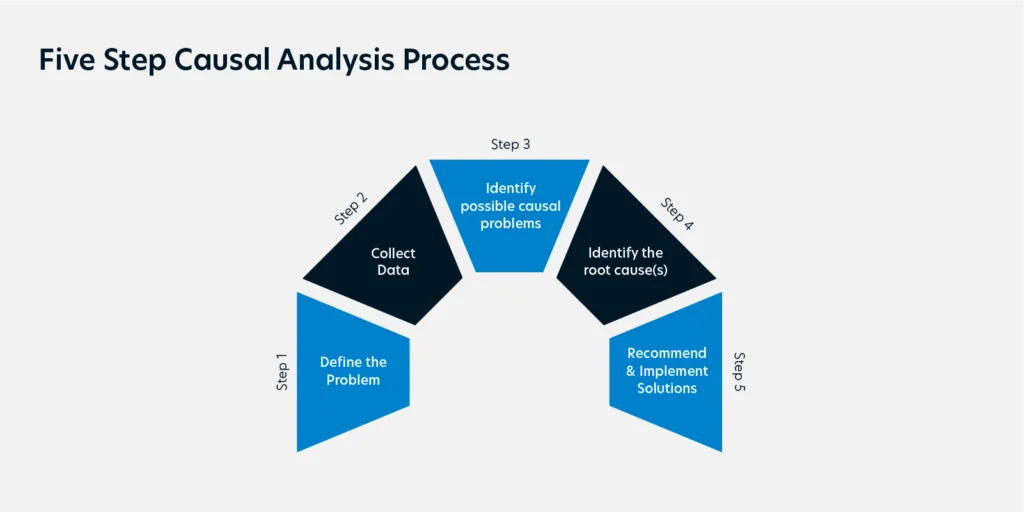
Causal analysis is crucial for businesses for several reasons:
By conducting causal analysis, businesses can make informed decisions based on a thorough understanding of the root causes behind certain outcomes or trends. This data-driven approach enables organizations to develop strategies that address underlying causes effectively and drive desired results.
Causal analysis provides businesses with the insights needed to inform strategic planning and goal setting. By identifying causal relationships between various factors, organizations can align their strategies with key drivers of success, mitigate risks, and capitalize on opportunities.
Understanding causality allows businesses to focus on improving key performance indicators by targeting the root causes of underperformance or inefficiencies. By addressing causal factors, organizations can enhance operational effectiveness, productivity, and profitability.
Causal analysis helps businesses anticipate and manage risks by identifying the factors that contribute to potential problems or failures. By proactively addressing causal relationships associated with risks, organizations can implement mitigation strategies and strengthen their resilience.
By uncovering causal relationships between different variables, businesses can identify new opportunities for innovation and growth. Causal analysis can highlight areas where interventions or changes can lead to positive outcomes, enabling organizations to adapt to market dynamics and drive sustainable growth.
Want more CX content? Check interesting blogs below!
The potential of AI analytics to optimize your business operations and drive innovation for seamless customer experience with data-driven solutions
Read moreSeamless IT operations with predictive analytics capabilities of AIOps can transform your incident management and prevent costly downtimes with AIOps solutions.
Read moreHarnessing the potential of data-driven insights to transform your business operations with augmented analytics and gain competitive advantage
Read moreRequest a free demo of Qinfinite, your AI-powered next-gen platform for operational excellence.
Request Free Demo